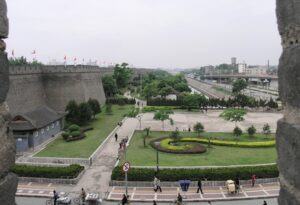 May 13, 2006
May 13, 2006
I am on a slow boat down the Yangtze, with even slower email.
Xian was, as it always is, wonderful. It has a past, as I mentioned, a long and glorious one. I am in awe of the first emperor, who died in 209 BC, after ensuring his immorality with the 7000 man army. They have opened three of the tombs, which the emperor started even before he became the emperor, and which employed over 350,000 people.
Here’s some interesting things we did:
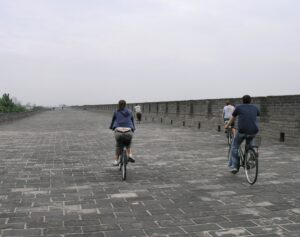 1) Xi’an is a walled city, with the existing wall first built in the late 14th century. The Communists finally completed rebuilding it, which led to a 14k bike ride one cool morning. The wall was not finished last time I was there.
1) Xi’an is a walled city, with the existing wall first built in the late 14th century. The Communists finally completed rebuilding it, which led to a 14k bike ride one cool morning. The wall was not finished last time I was there.
2) We went (a few students and I) to a church service. I was curious about the church, which was built in the 1920s by one of the missionaries for a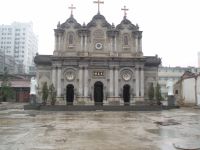 (then) famous warlord, who baptized his troops with a fire hose and marched his troops to “Onward Christian soldiers.” I had never found that building before.
(then) famous warlord, who baptized his troops with a fire hose and marched his troops to “Onward Christian soldiers.” I had never found that building before.
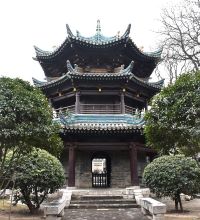 3) One of my favorite places (not usually on the itinerary for Westerners) is the Great Mosque. As the capital of China and the beginning/end of the Silk Road, Xi’an attracted many foreigners. The Muslims came and stayed. There are about 10.000 in the city today (out of 7 million), most in the quarter around the mosque. We went first thing in the morning (17 of the 27 came voluntarily). Built first in 742, the mosque looks like a typical Chinese building, the minaret looks like a pagoda. Amazingly serene.
3) One of my favorite places (not usually on the itinerary for Westerners) is the Great Mosque. As the capital of China and the beginning/end of the Silk Road, Xi’an attracted many foreigners. The Muslims came and stayed. There are about 10.000 in the city today (out of 7 million), most in the quarter around the mosque. We went first thing in the morning (17 of the 27 came voluntarily). Built first in 742, the mosque looks like a typical Chinese building, the minaret looks like a pagoda. Amazingly serene.
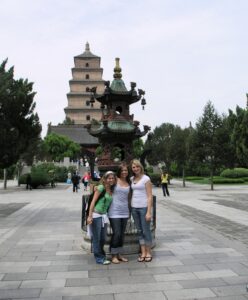 4) We visited two Buddhist pagodas, including one where Xuan Zang brought the original books from the Buddha in the 8th century.
4) We visited two Buddhist pagodas, including one where Xuan Zang brought the original books from the Buddha in the 8th century.
5) Dumplings are one of the specialties of Xi’an, so of course when we had a free mealtime, we went there for the 18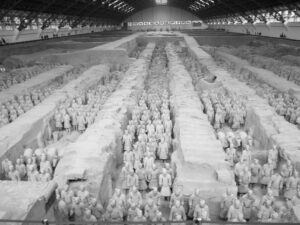 varieties…quite a meal.
varieties…quite a meal.
6) And the underground army.
From Xi’an, we flew an hour south to the largest city in the world (partly because of the size of its “territory”) Chongqing. A sleepy city until the Second World War, it grew enormously when the Nationalist government fled there in 1937. There are now 30 million people 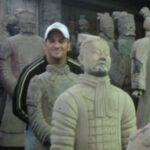 in the municipality, but about 70% are in the surrounding counties.
in the municipality, but about 70% are in the surrounding counties.
There is not much to see in the city itself, which has been rebuilt considerably since the first time I came to it about a decade ago. One highlight is the only museum in China to honor an American, General Stillwell, who commanded American and Chinese troops in World War II, but clashed with Chiang Kai-shek and eventually was fired.
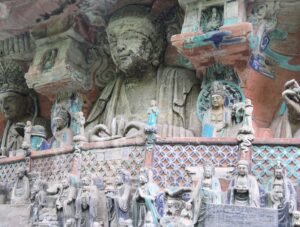 We spent the day traveling to a Buddhist grotto where a serious monk had carved statues in in the late Sung dynasty period–our guide gave a great explanation of how Buddhism embraced both existing Chinese religions–Confucianism and Taoism.
We spent the day traveling to a Buddhist grotto where a serious monk had carved statues in in the late Sung dynasty period–our guide gave a great explanation of how Buddhism embraced both existing Chinese religions–Confucianism and Taoism.
Sichuan is also one of the main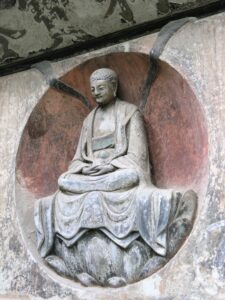 cuisines of China, so we went to a local restaurant for a hot pot. I bought some spices and if they make it home, we will try one on a campout. You chop everything and put it in boiling soup with spices, and take it out a few minutes later.
cuisines of China, so we went to a local restaurant for a hot pot. I bought some spices and if they make it home, we will try one on a campout. You chop everything and put it in boiling soup with spices, and take it out a few minutes later.
We got on the boat last night and sailed down the Yangtze. They gave all the women flowers for Mother’s’ Day, so let me close by saying happy Mothers’ Day to you all.